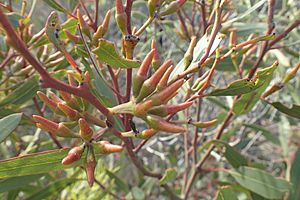Eucalyptus luteola facts for kids
Quick facts for kids Eucalyptus luteola |
|
|---|---|
 |
|
| Eucalyptus luteola north of Ravensthorpe | |
| Scientific classification | |
| Genus: |
Eucalyptus
|
| Species: |
luteola
|
The Eucalyptus luteola is a special kind of eucalyptus tree that only grows in a small part of Western Australia. It has smooth grey bark, but near the bottom, it has rough, grey ribbons. Its adult leaves are long and narrow, like a spear. When it blooms, it has groups of 11 to 13 flower buds that open into pretty lemon-yellow flowers. After flowering, it grows fruit that looks like a small cylinder or barrel.
Contents
What it Looks Like
The Eucalyptus luteola is a type of mallee, which is a small eucalyptus tree. It usually grows to be about 1 to 5 metres (3 to 16 ft) tall. It has a special woody swelling at its base called a lignotuber. This helps the plant regrow after a fire.
Its bark is smooth and grey, but closer to the ground, it has rough, grey strips that look like ribbons.
Leaves and Flowers
Young Eucalyptus luteola plants have leaves that are shaped like an egg or a spear. These young leaves can be up to 70 mm (2.8 in) long and 30 mm (1.2 in) wide.
The adult leaves are a slightly shiny green on both sides. They are long and narrow, like a spear, measuring 60–95 mm (2.4–3.7 in) long and 8–15 mm (0.31–0.59 in) wide. They narrow down to a stalk called a petiole, which is 7–17 mm (0.28–0.67 in) long.
The flower buds grow in groups in the leaf corners. They are on a flat, unbranched stalk called a peduncle, which is 10–17 m (33–56 ft) long. Each individual bud has its own small stalk, a pedicel, about 3–5 mm (0.12–0.20 in) long.
Buds and Fruit
When the buds are ready, they are shaped like a spindle, about 18–19 mm (0.71–0.75 in) long and 3–4 mm (0.12–0.16 in) wide. They have a horn-shaped cap called an operculum. This cap is about three times longer than the base of the flower, which is called the floral cup.
Eucalyptus luteola flowers bloom from February to April. Their flowers are a bright lemon-yellow color. After the flowers, the plant produces woody fruit. This fruit is shaped like a cylinder or a barrel and is about 6–8 mm (0.24–0.31 in) long and 5–7 mm (0.20–0.28 in) wide.
Naming the Plant
The Eucalyptus luteola was first officially described in 1991. This was done by two scientists, Ian Brooker and Stephen Hopper. They found a sample of the plant near Lake King in 1985. Their description was published in a science journal called Nuytsia.
The second part of its scientific name, luteola, comes from a Latin word. It means "pale yellow," which describes the color of its flowers.
Where it Lives
This mallee plant grows in rolling hills between Hyden and Ravensthorpe in Western Australia. It prefers to grow in sandy soils.
How it is Protected
The Western Australian Government's Department of Parks and Wildlife has looked at the Eucalyptus luteola. They have classified it as "not threatened." This means it is not currently in danger of disappearing.




